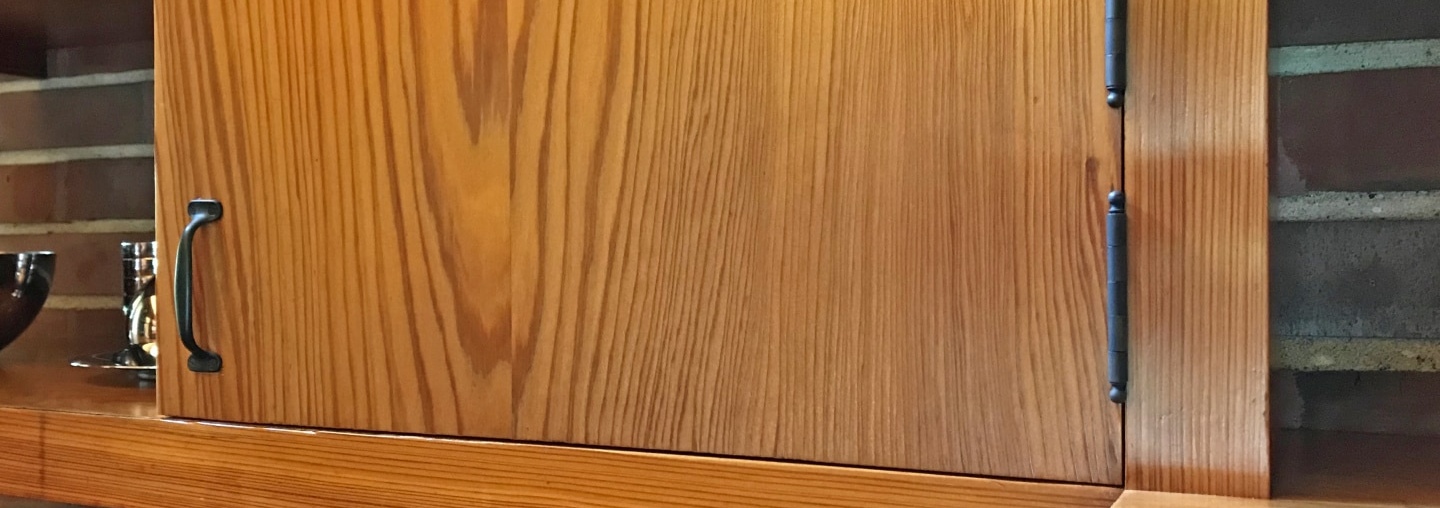
Willey House Stories Part 9 – Hucksters, Charlatans, and Petty Criminals
Steve Sikora | Nov 12, 2018
Every house has stories to tell, particularly if the house was designed by Frank Lloyd Wright. Some stories are familiar. Some are even true. Some, true or not, have been lost to time, while others are yet to be told. Steve Sikora, owner of the Malcom Willey House, continues his exploration of the home and its influence on architecture and society.
Frank Lloyd Wright and Nancy Willey discussed local resources such as golden hued Minnesota stone, white oak and birch, but ultimately, settled on two types of regional, common red brick and Red Tidewater Cypress as the palette of materials for her new home. The brick was readily available and affordable. Cypress was a wood that Wright possessed a personal affinity for. Consequently, after Willey, it became the specification of choice for many of his Usonian homes.
As you will learn, the name Cypress, can apply to a variety of different trees, so let’s first define the wood Wright specified, to alleviate some confusion. Taxodium distichium, the taxonometric name for a tree with the common names; Bald Cypress, Swamp Cypress or Red Tidewater Cypress is the species Wright specified for use, both on the interior and exterior at the Willey House. The millwork specifications called for:
Outside work to be of air-dried cypress, clear.
Window frames to be firmly set true to position (see details).
Inside doors 1-1/8” slab cypress, attached veneer – 5 ply. Outside doors 2 ¼” thick compound core.
Inside trim – (see details) to be of kiln-dried cypress, clear.
Red Tidewater Cypress trees are large, aquatic, deciduous, coniferous trees in the family Cupressacae. In some respects they resemble coastal redwoods but annually shed their needles like the northern Tamarack or Larch, hence the name “Bald Cypress”. Grown in standing water, they are known to lift bent root knobs (or knees) above the surface for oxygen. Cypresses can grow to the towering height of 120 feet and girth of 6 feet in diameter, although ancient specimens have grown much larger. Both grain and color are wildly variable. The sapwood tends to be a pale yellow to white, like pine, but can also exhibit reddish, chocolate, or olive hues. These pale colors blend gradually into the heartwood, which can range from yellow, to brown, to red to near black. Coloration is dictated by whether the tree grew in a muddy swamp, a river or upon drier land. Grain patterns range from straight to highly figured. Cypress wood is dense and has very few knots. It is superbly workable, easily machined and finished, making it ideal for use in furniture. The wood is soft and fine textured. Trees tend to rot from the center, so Cypress heartwood is the part of the tree particularly defiant to weather and all other sources of decay. Because of this, Cypress was historically employed in cooperage for the construction of water tanks, vats and tubs, favored for its rot resistance, but also because it was chemically inert and did not impart flavor to what it contained, making it a popular choice for food manufacturers, breweries, wineries, and other companies wishing to avoid gustatory (taste) or olfactory (smell) contamination in their products. In the building trades Cypress is renown for its durability, Cypress wood is optimal for exterior uses, including siding, trim, decks, fences, shutters, window boxes, in addition to landscape design elements. Rot resistance in Cypress can be attributed to the high cypressine content in the wood. Cypressine is a non-sticky resin manufactured by the tree during annual growth. It impregnates the heartwood and acts as a natural preservative, stemming fungal growth and decay.
There are obvious reasons why Frank Lloyd Wright favored Red Tidewater Cypress; its integral beauty, in the form of figured grain patterns, its lasting durability, and its minimal requirements for finishing.
Despite its specification for the Willey House, Cypress is not indigenous to Minnesota. It is native to the southern United States, in a range from the Gulf of Mexico to the east coast. It was distributed widely during its period of commercial logging, roughly between 1640 and 1940. Extremely common in the South, nearly every house built in old New Orleans is made of Cypress. Grown in or near water, fresh cut Cypress wood has, an unusually high moisture content, as much as 30-40%. Old growth, river reclaimed wood can be even wetter. From the first, harvesting Cypress has been a difficult and expensive undertaking. Canals were dug through the swamps ostensibly to float logs. However, the water content of green Cypress logs prevented them from floating – a considerable problem when harvesting trees from deep within swamplands. The timber companies employed two solutions. One practice entailed girdling the massive trees to kill them several months before harvesting, in order to lower the moisture content and make them more buoyant. Another, more resource-intensive solution, was to drive piles in the swampy ground and erect elevated railroads to move the massive logs. As one can imagine, many logs were lost in the harvest, only destined to be reclaimed much later.
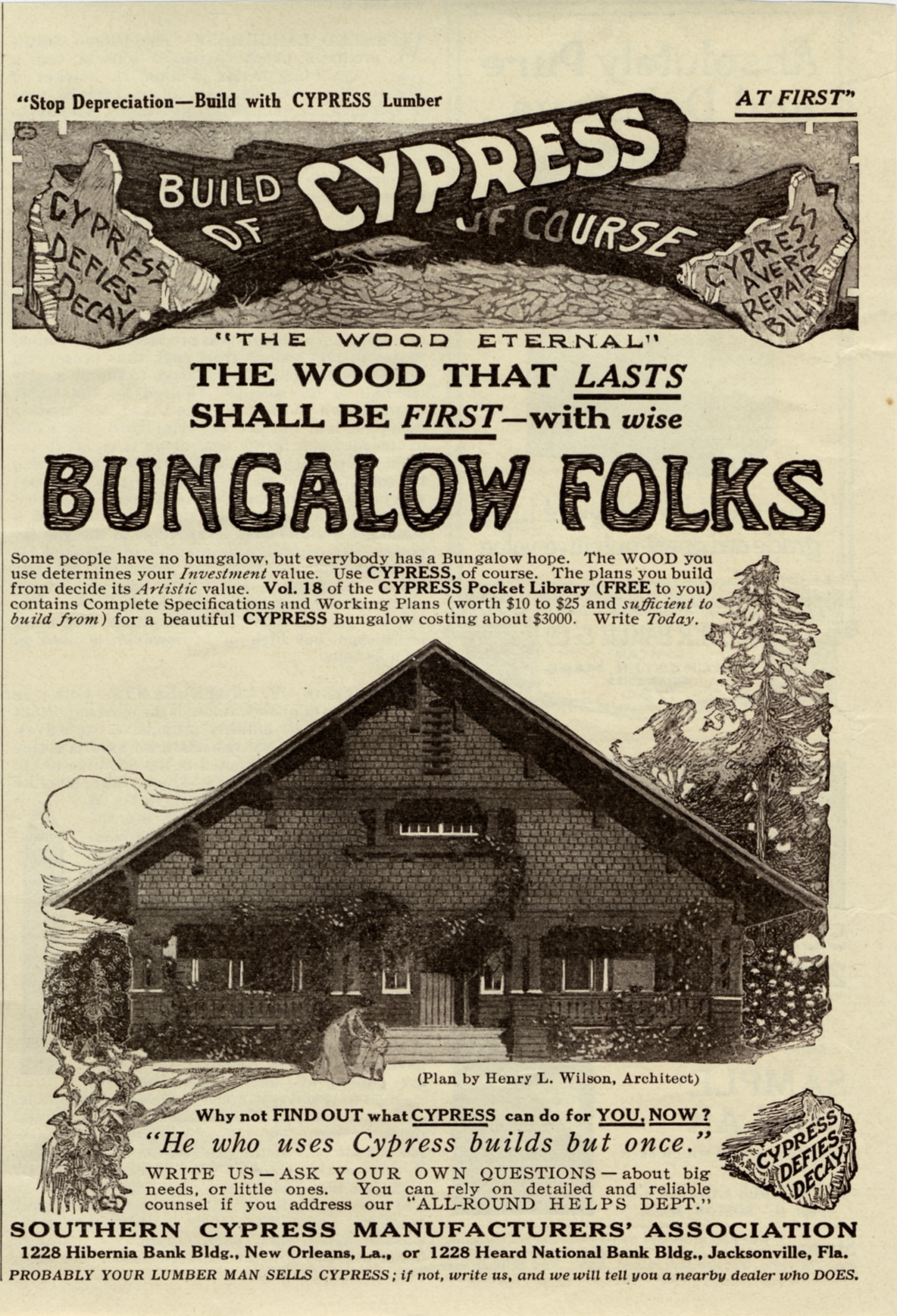
Red Tidewater Cypress was marketed as “The Wood Eternal.”
The species has, in recent years been popularized by the reality TV show Ax Men, which features a motley cast of backwater characters who, all too clearly demonstrate the dangers of recovering lost, first-growth logs from Southern swamps and rivers. The imaginative, jerry-rigged technologies employed by the men and women, foolhardy enough to aqua-mine the long forgotten logs, helps to explain the absurd board foot cost of reclaimed Cypress lumber.
Cypress was marketed by the Southern Cypress Manufacturers’ Association as “The Wood Eternal.” According to Edgar Tafel, Frank Lloyd Wright used that same phrase to describe the wood. I was curious about Wright’s use of Cypress prior to the Willey House and sought outside expertise. Looking backwards from the first scheme for the Willey House in 1932, Stafford Norris suggested that the next earliest use of Cypress was at the Graycliff Estate, built 1927, in Derby, New York on the shores of Lake Erie. Pat Mahoney, Vice President of the Graycliff Conservancy confirmed that fact. Apparently Wright sent charred samples of Cypress to Darwin and Isabelle Martin when discussing its possible use at Graycliff. Pat believes the singed wood he sent may have been remnants of the Taliesin II fire. The Martins were initially opposed to the idea of Cypress at Graycliff because the wood had been unsatisfactorily employed as an exterior trim detail on the Darwin Martin House in Buffalo. There, Wright specified it be coated with shellac. The shellac repeatedly peeled and eventually the trim required painting. Shellac as a wood sealer is unsuitable for exterior use. When dry, it becomes brittle. It creates a vapor barrier that cannot breathe and eventually flakes and peels. Despite their concerns, Wright’s arguments for its use must have been persuasive because floors, trims and furnishings are all of Red Tidewater Cypress at the Graycliff Estate.
Wright’s earliest, principal use of Cypress was at his own home in Spring Green, Wisconsin. Even after the 1914 fire, Wright chose Red Tidewater Cypress for every rebuilding of Taliesin, Spring Green. Though it could not be locally obtained from the surrounding hillsides as many of his materials were, Ryan Hewson, Preservation Manager at Taliesin Preservation, Inc. confirmed that Wright specified the wood. Kieran Murphy, Historian at Taliesin Preservation Inc. shared passages from Frank Lloyd Wright Collected Writings: 1930-32, volume 2 and Wright Studies, vol. 1: Taliesin 1911-14 that corroborates his specification of Cypress for both Taliesin I and II. And as is evident today, Taliesin III is composed of Red Tidewater Cypress throughout.
Starting with the Willey House, Cypress became a principal wood of choice for Wright’s Usonian houses. It was sometimes substituted with Coastal Redwood, particularly in western states where that resource was plentiful. Later Usonians, used Philippine Mahogany. In one rare case, Larch was employed. In a 2017 survey of owners of Usonian houses conducted by the Frank Lloyd Wright Building Conservancy, with 62 respondents, Cypress was identified as the principal wood used in Usonians. It was the predominant exterior material in 39.1% of cases and the predominant interior material in 41.5%. Cypress is followed closely by Mahogany at 25.5 and 37.4% respectively. Philippine Mahogany was specified, as virgin Cypress stands dwindled. In 1939, L. Cook, Chief of Forestry of the National Park Service declared “In Louisiana, Cypress logs that have been lying on the ground for many years are now being salvaged due to the growing scarcity of standing timber of large size.” From the late 1930s Cypress was already being reclaimed from earlier logging operations. The Conservancy Survey had no respondents whose homes were built of Redwood, though several are known to exist. It is interesting to note that in every instance, Wright considered the longevity of his buildings, by specifying woods known for their high resistance to decomposition.
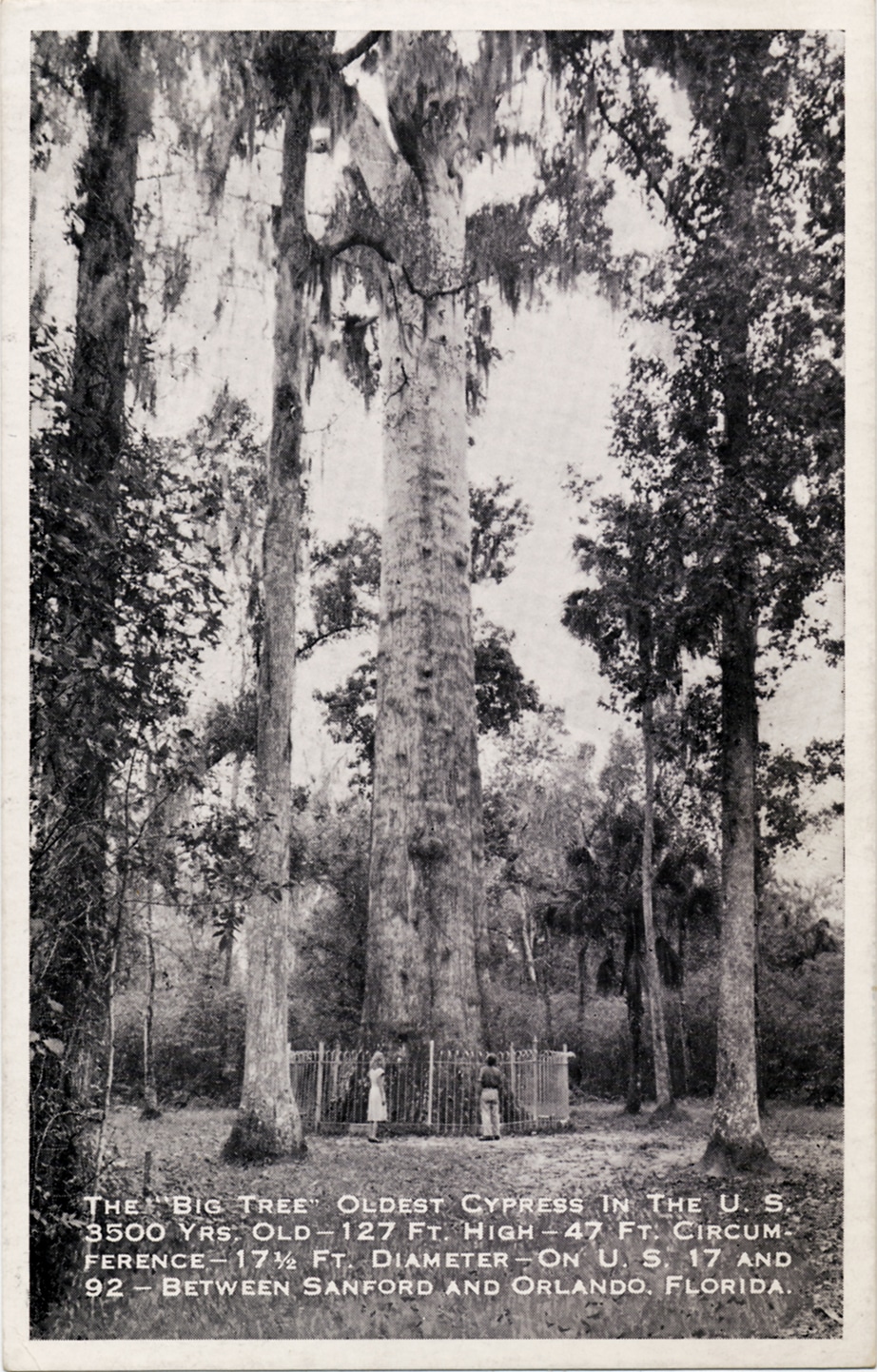
Vintage postcard view of the “Senator” an ancient, Red Tidewater Cypress, estimated to be 3500 years old.
When we acquired the Willey House in 2002, the hue and tone of the Cypress elements varied dramatically throughout the house, even from one end of a room to the other, depending on their exposure to direct sunlight. Three skylights are located on the south side of the living room. Cypress trim within the skylights received direct southern sun exposure. Those boards appeared to be the color of deep stained mahogany, while wood cabinetry in the dining alcove twenty feet away were a golden-toned, medium brown. It soon became clear as to why. Whenever a load of fresh milled, Cypress planks were delivered to the house, they would be laid out on the living room floor to acclimate, usually for a period of months. Stafford noticed when he restacked the wood, after only a week or so, areas where boards overlapped left sharply defined impressions of the board above it, recorded in a lighter tone due to the absence of sunlight. The effect was that of a solargram or sun print made by placing an object on top of photosensitive paper exposed to sunlight. Cypress, like a few other woods, is photo reactive. Light, fresh cut wood darkens quickly in the presence of sunlight. This property makes the restoration of clear finished Cypress, especially tricky where new must match to old, an added challenge to restoration.
A print from Nancy Willey’s photo album shows her new dining room furniture in place, circa early 1935. The wood appears to be unfinished and is bright white in tone. Cypress in the house all began as light as pine. Nancy confirms this in a letter she wrote to Taliesin, concerning the feet of her new upholstered chairs, in February of 1938: “I was horrified at first when I saw the woodwork. It is dark stained, and probably mahogany or cherry. I certainly had expected our light cypress, and thought of course that it was a terrible mistake. But Malcolm calmed me down and suggested that perhaps you specified the dark wood for good reasons. Your own chair was dark. I have gotten quite used to it now: the effect is to make the framework of the chair quite inconspicuous.”
In the restoration of the Willey House we acquired old-growth Cypress from multiple sources, all within the Deep South. Our wood came from an assortment of hucksters, charlatans and petty criminals, or in industry parlance, “wood brokers.” Frustrated by years of disappointment in dealing with our clutch of shady suppliers, Stafford at last found one honest man and has been committed to him ever since. Even when partnered with a trusted resource, the Cypress products available can be daunting and confusing. The market variations on the theme of Red Tidewater Cypress include: old growth (source unknown), sinker (from submerged logs), tank (reclaimed wood from water tanks and vats), pecky (a wood with tunneled perforations caused by a fungal disease that afflicts an estimated 30% of all Cypress trees).
The Willey House restoration required old growth Cypress planks and veneers, for replacement of lost or damaged wood and construction of un-built furniture. The only options available were recovered trees from southern swamps and rivers, or salvaged wood from previous uses. For instance, to get a particular dimension and length boards for cutting base shoe, we purchased a batch of planks from a decommissioned water tower. Each salvage source bore its own peculiar characteristics. We found that wood submerged underwater for 100 years or more seemed to acquire a mineral content further influencing color, weight and density. Water pressure acting on sunken logs affected the grain, making already tight, old growth grain more dense. The river recovered logs were cut into slabs and shipped with an extremely high moisture content, which made its behavior as unpredictable as a toddler in church as it dried. If boards twisted, warped or checked, which they did approximately half of the time, the final, useable dimension was reduced by whatever was lost milling it into a straight board again, if it proved usable at all. Reclaimed Cypress should be slow-cured outdoors for 6 months or more after harvest. Cypress can also be kiln dried but is more successfully air-dried before it is ready to be worked.
Old growth Cypress trees can live to be 3,500 years old. The differences in grain patterns between a merely mature tree and an ancient one is incomparable. The biological history of a venerable old growth tree recorded in swirling grain pattern makes a powerful statement. It leaves the impression of being in the presence of something primordial, and rightly so. As you can imagine, it took time to locate the appropriate wood for each aspect of the restoration. Sourcing Cypress veneer for making plywood posed the greatest challenge. We were unsuccessful at locating precut, old growth veneer with the irregular, highly-figured patterning required. Our only recourse was to buy a partial log and have our own flitches cut from it. The reward for the extra effort is evident in the intoxicating patterns to be found only in old growth Cypress, now writ large in nature’s cursive across the cabinet faces adorning the restored Willey kitchen.

Dining room cabinets made for Cypress veneer doors and solid boards. Photo by Steve Sikora.
Wright’s attraction to Cypress trees can be traced back to his idyllic months in Italy with Mamah Borthwick, in the year 1910. Both Keiran Murphy and Pat Mahoney independently cited Wright making mention of Cypress while residing in Fiesole, Italy during his year in Europe. The landscape above Florence was graced with tall and venerable, Italian Cypress trees, portrayed so vividly in Ron McCrea’s book Building Taliesin. McCrea describes the ruins of a Roman amphitheater and spa just a short walk from Villino Belvedere where Frank Lloyd Wright and Mamah Cheney lived. “At this cool and inviting altitude, visitors to the classical retreat enjoy a refreshing view of the Tuscan hills framed by cypress trees.” But Italian Cypress is nothing like its American counterpart. Italian Cypress, also called the Mediterranean or Tuscan Cypress is a coniferous evergreen capable of growing to the height of 115 foot tall. Its elegant, elongated shape is the standard, vertical element in Italian gardens. This tree is also very long-lived, with some trees recorded to be over 1,000 years in age. Italian Cypresses require a Mediterranean climate, zones 7-11 to survive. Like its New World counterpart, the Italian tree is steeped in myth and lore. Since ancient times, Italian Cypress has been a symbol of mourning, death and the afterlife. Today it remains the principal cemetery tree throughout the Middle East, Europe and now, the Americas. In Greek mythology the tree was associated with the underworld. Cypress wood is also reputed to be the wood of the crucifixion. Both Cypresses (Red Tidewater and Italian), stem from the family, Cupressacae, both are renown for durability and resistance to decay. However, Tidewater Cypress and Italian Cypress are radically different tree forms, indigenous to separate continents, thriving under inverse environmental conditions. The Cypress Wright built with, and the Italian landscape specimen of his fondest reveries, are not identical. The colonnade aesthetic of Italian Cypress is however, duplicated in the American Midwest by another related tree. This one is an arborvitae.
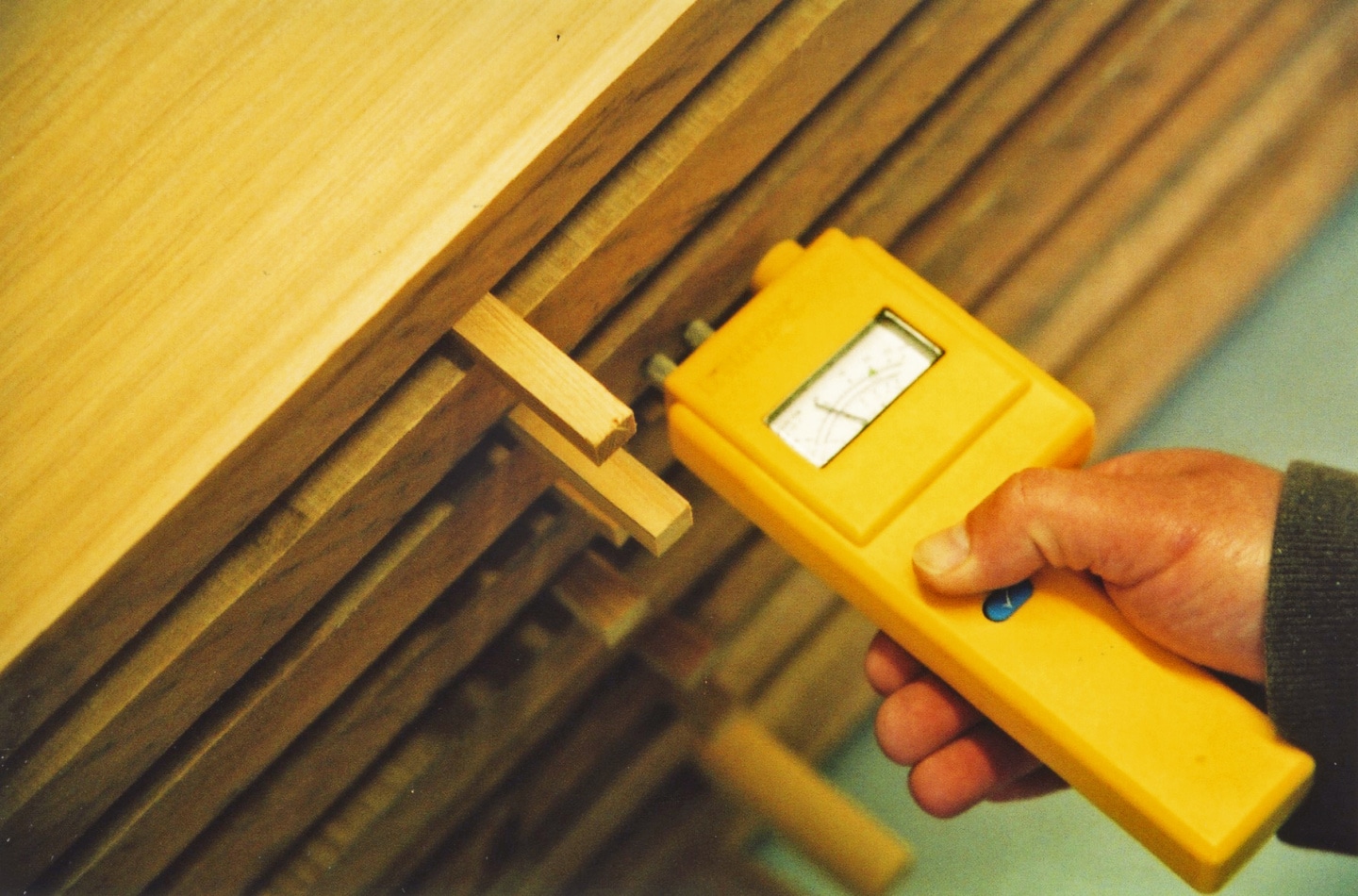
Stafford uses a moisture meter to determine percentage of water content in Cypress boards. Photo by Steve Sikora.
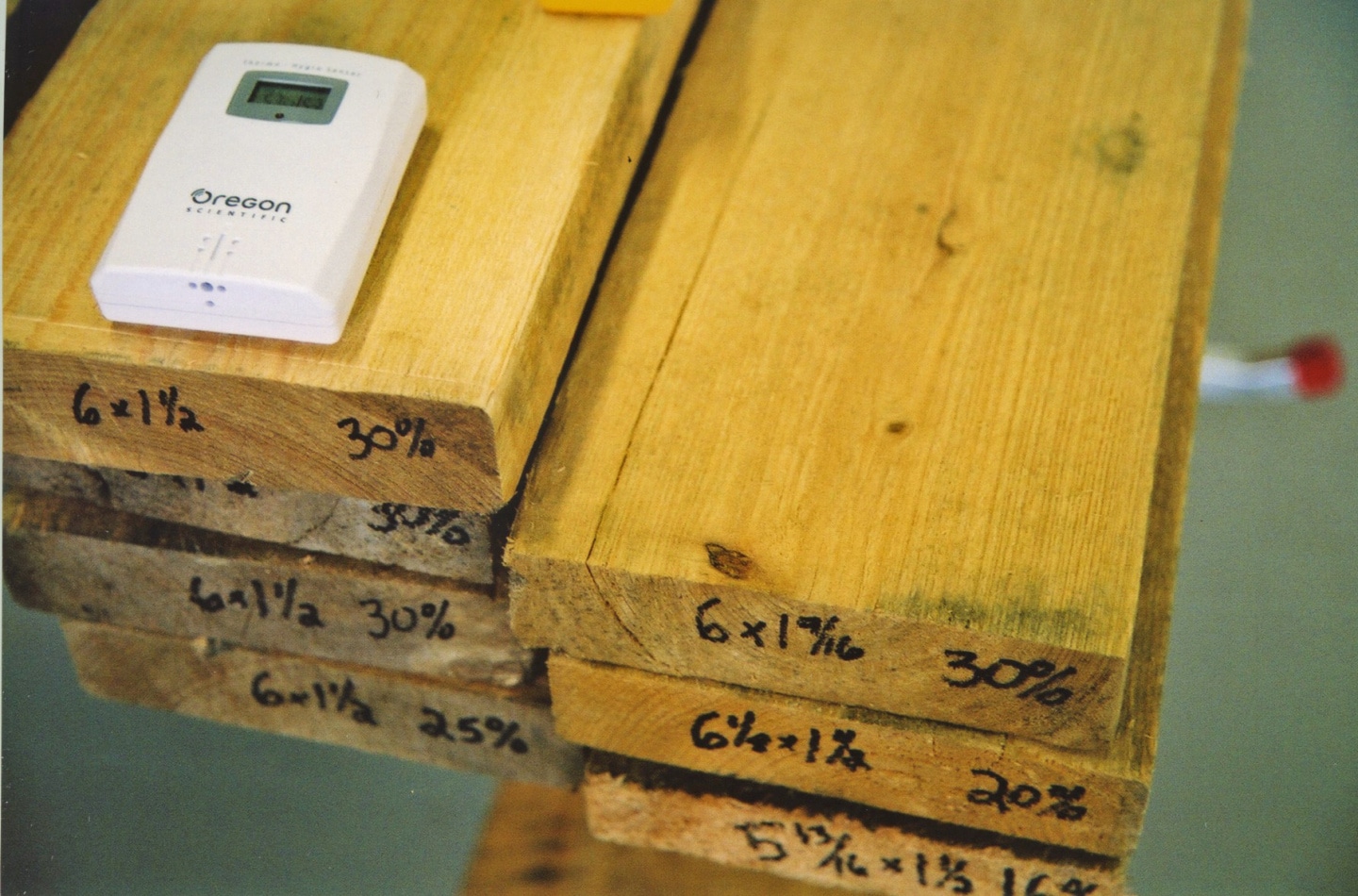
Acclimating Cypress boards labeled with initial moisture content. Photo by Steve Sikora.
Though planting strategies were implied in published plot plans for the Willey House, no formal garden plan was ever submitted by Taliesin. Nearly a year after the Willeys took up residence in their new home, Nancy wrote to Frank Lloyd Wright to ask what she should plant. In a written response on September 22, 1934, Gene Masselink outlined Wright’s general landscape plan for the Willey House. “The planting arrangement will consist of juniper, sumac and cypress. The gardens at the back should consist of brilliant flower arrangements which will be worked out definitely later.” Wild Sumacs appear in photos dating back to the mid 1930s, and they still abound today. Low spreading Junipers, a Wright favorite, lined the driveway and entry steps for a number of years, based on photos in Nancy’s album. There is no historical evidence pointing to the use of Cypress at Willey. Perhaps, because the lot was already populated with native Burr Oaks, she decided to forego the tall Cypress. Or maybe Nancy Willey confused his suggestion of “Cypress” with the Red Tidewater Cypress her house was composed of. Neither of the Cypresses are winter hardy in Wisconsin or Minnesota. Surely Wright was aware of this. What he was referring to is a third tree. The Midwestern landscape substitute for Italian Cypress, lining the cemeteries of the northern tier states sometimes called “Cemetery Cypress,” a tall, columnar tree that resembles Wright’s beloved Italian Cypress. Cemetery Cypress is actually an arborvitae, Thuja occidentals. Other than a passing resemblance in form to its noble Italian cousin, it is different in every way from the first two types of Cypress species discussed earlier, yet it also is a member of the family Cupressacae. This native Midwestern tree is also called by the name Northern White Cedar. Wright would have been familiar with them. They are well represented in the State of Wisconsin. In unfenced, rural cemeteries, the bare trunks are exposed to a height of approximately five feet. That is the Plimsoll line, the limit to which deer are able to browse the foliage in winter.
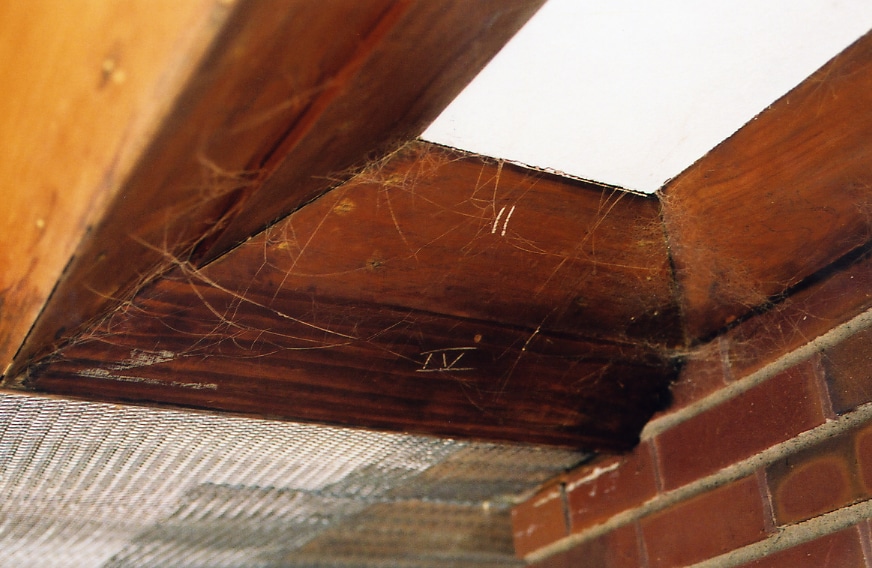
Cypress trim below the Willey House skylights sun-darkened to a rich, dark brown. Photo by Steve Sikora.
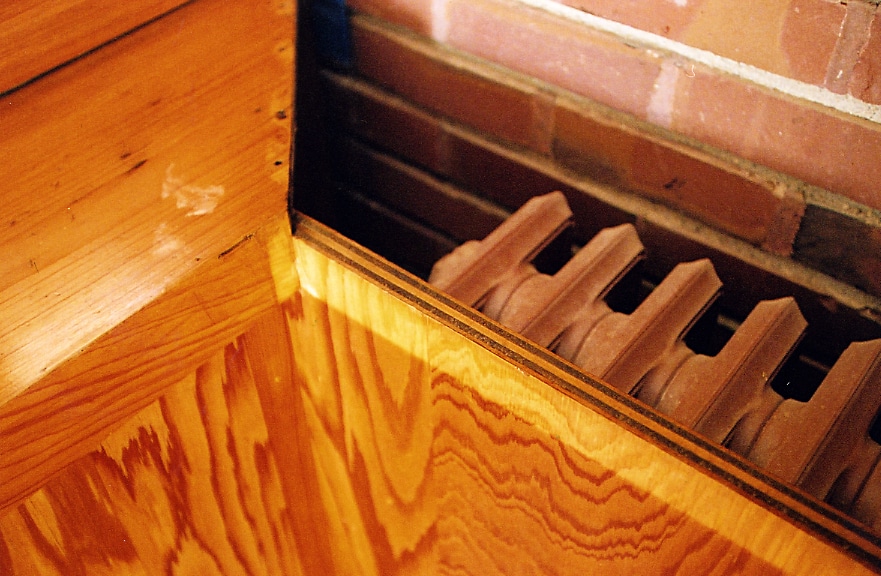
Ghost on unexposed wood shows the effect of sunlight on a Cypress radiator enclosure.Photo by Steve Sikora.
Though true Italian Cypress was at some point introduced to North America, Wright specified this hardy, indigenous original to take it’s aesthetic place. Ironically apropos to this story, White Cedar was the first tree exported to Europe from America, a gift from the boreal forests of the New World to King Francis I. In 1535 the French explorer, Jacques Cartier, who claimed Canada in the name of France, was directed to a tree the natives called annedda, as a remedy for the scurvy his men were suffering, over the long, Canadian winter. The French called the miraculous tree, l’ arbe de vie, the tree of life. The Latin version of its name is arborvitae. The etymology of Thuja stems from the native practice of burning White Cedar as incense. Thuja comes from the Ancient Greek Thuya, which means “to sacrifice” or thusia, a burnt offering. Native American legends regard White Cedar as sacred. It is a tree of great medicine; cleansing, protective and purifying. It is believed that deities reside in White Cedar. Sioux and Iroquois instruments of power were fashioned from the wood of the tree. White Cedar is one of the four plants represented in the Ojibwe medicine wheel, where it is also associated with the north. This third type of Cypress is again steeped in myth and employed in ritual.

Commercial Cypress varieties by source. Photo by Steve Sikora.
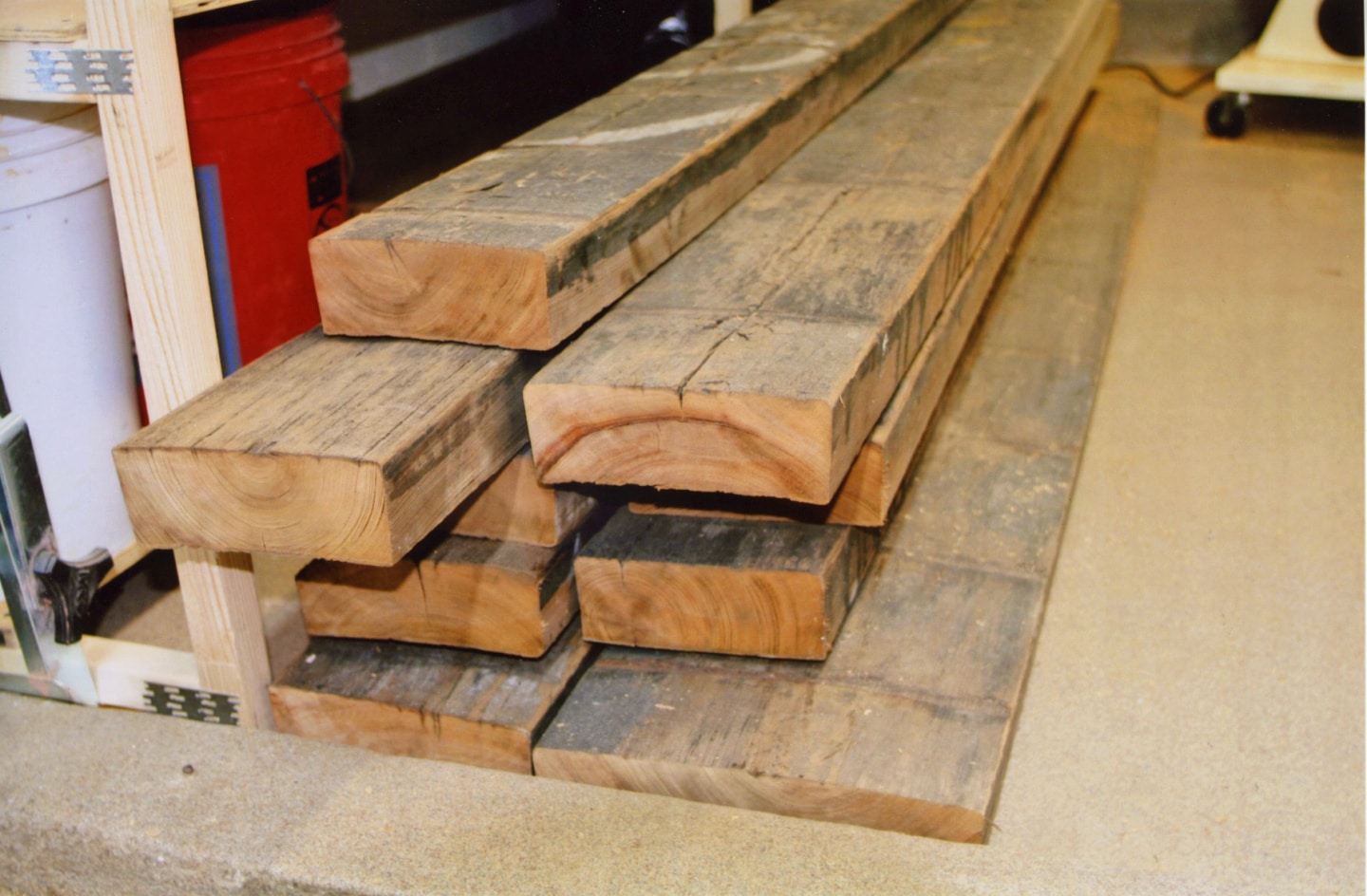
Cypress from decommissioned water tank. Note all boards are heartwood. Photo by Steve Sikora.
In August 2018, during an extreme, monsoon-related, weather event, a tall evergreen spire that stood near the Music Pavillion at Taliesin West was toppled by intense wind force and torrential rain. This tall evergreen, referred to as a “Cypress,” was planted by Mr. and Mrs. Wright in the 1950’s, recalled by Minerva Montooth. Photos of the late Taliesin West Cypress show it to be the Cemetery Cypress of the Midwest rather than Italian Cypress of the Mediterranean. With adequate irrigation the Arborvitae, Thuja occidentals will grow in Arizona and is sold by Phoenix area nurseries. This “tree that escaped the crowded forest” may have been a living metaphor for a Midwestern native transplanted into the desert Southwest, or aesthetically may have served as a bittersweet reminder of a romantic season spent in Italy once upon a time. Then again, it may have simply existed as a towering vertical element, counterpoint to the extreme horizontal composition of Taliesin West.
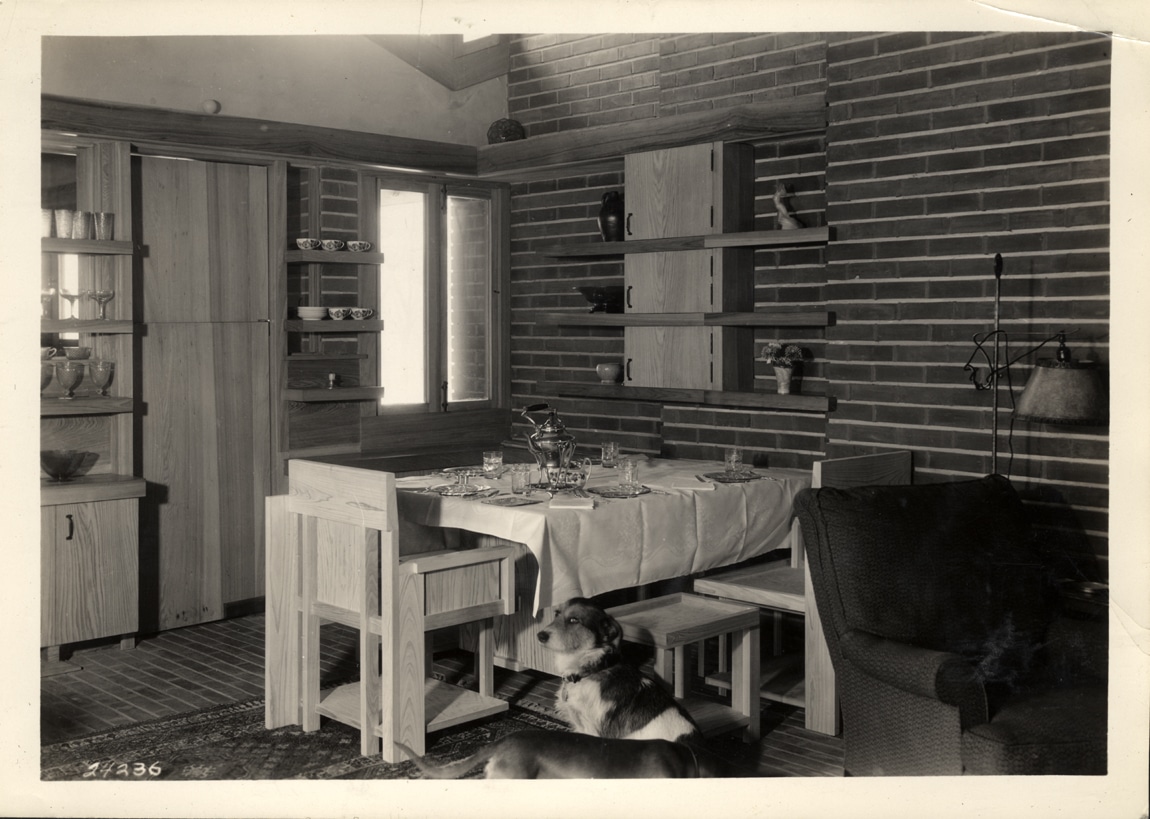
A snapshot from Nancy Willey’s photo album, showing the new, bright white Cypress dining set. Photo courtesy Willey House collection.
Today, at the Willey House, we cultivate a privacy hedge planted in Arborvitae, Thuja occidentalis ‘Techny’. It is a more compact cultivar of the familiar Cemetery Cypress. Technically, that’s four Cypresses now in this story. Ours are not used as the strong vertical accents Wright may have imagined. The native Burr Oaks still provide that service. Instead, the Arborvitae at Willey obscure the view of a freeway noise barrier wall and help maintain year-round garden privacy.
The nature of materials is key to Wright’s organic philosophy. His palette always includes undisguised natural materials that serve to ground the physicality of the design. But his material choices often bear an immaterial quality as well – a kind of spirituality. It is certain that in the end, each of the Cypresses; the venerable Leviathan rising from the dark swamp, the legendary Italian Cypress of ancient Rome and the wistful Cemetery Cypress standing sentinel over the dearly departed, are each in their own way symbols of beauty, serenity and eternity. And each mythical Cypress provides a source of useful wood, every bit as enduring as the legends that surround these fabled trees themselves.
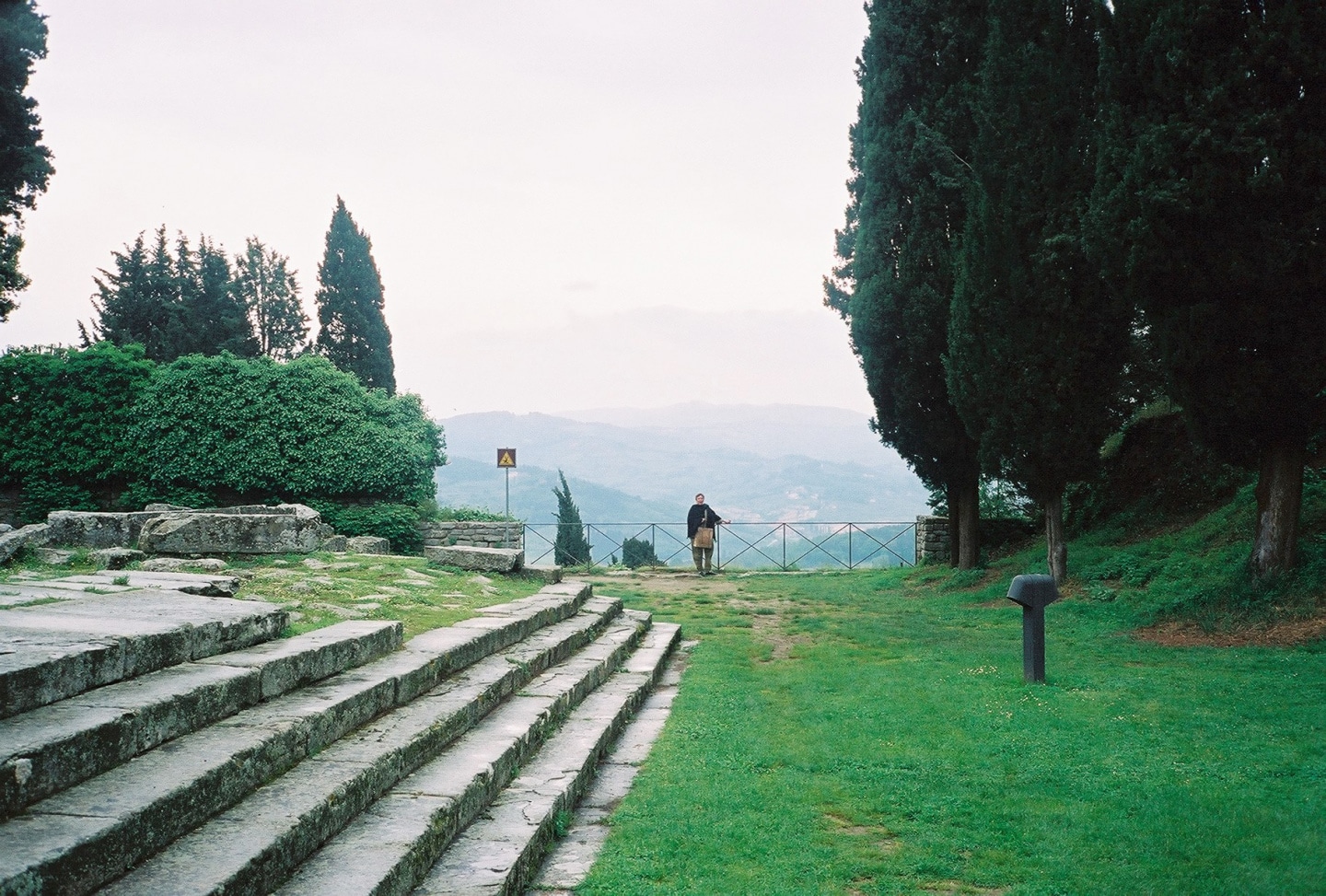
Italian Cypress at the anthropological park off the piazza in Fiesole. Elaine McCrea in the distance. Photo by Ron McCrea.

Cemetery Cypress near Siren, Wisconsin. Note the Plimsoll line, showing the height to which deer browsed during winter. Photo by Steve Sikora.
READ THE REST OF THE SERIES
Part 1: The Open Plan Kitchen
Part 2: Influencing Vernacular Architecture
Part 3: The Inner City Usonian
Part 4: A Bridge Too Far
Part 5: The Best of Clients
Part 6: Little Triggers
Part 7: Step Right Up
Part 8: A Rug Plan



